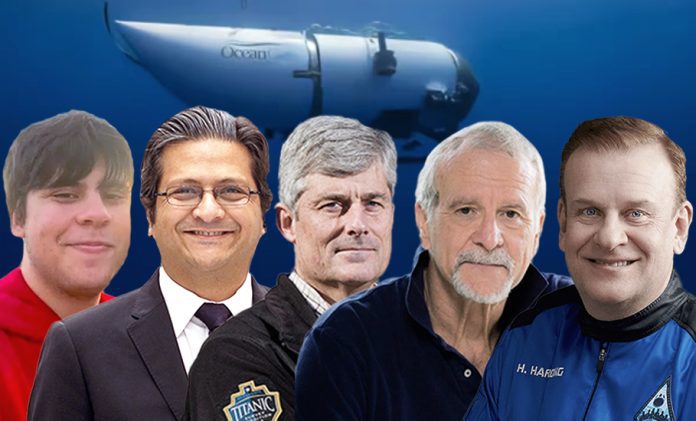Titan remains found near shipwreck after implosion, men died in milliseconds: Titanic submersible tragedy

The Titanic exploration submersible’s resting place is right next to the shipwreck punters had paid big money to visit, and it is believed those on board died “in milliseconds” after a “catastrophic implosion”.
The five men on Titan – Hamish Harding, Stockton Rush, Paul-Henri Nargeolet, Shahzada Dawood and his son, 19-year-old Suleman Dawood – “would have had no idea what was happening” when they died, one expert has said.
Suleman Dawood’s aunt, Azmeh Dawood, told NBC her nephew was “terrified” ahead of the trip: “[He] wasn’t very up for it. I am thinking of [him] in there, just perhaps gasping for breath.”
A search and rescue effort led by the United States Coast Guard and involving aircraft, ships and underwater equipment from Canada and France ended overnight Thursday, NZ time, when debris was found near the Titanic.
It has also been revealed by an anonymous senior US Navy official an acoustic system used to detect submarines recorded an “anomaly” on Sunday – the day Titan went missing – which was likely the sound of the fatal implosion.
https://www.iheart.com/podcast/1049-the-front-page-30038501/episode/the-titan-submarine-disaster-what-went-117900761/?embed=true&pname=nzh_web&sc=podcast_episode It came as Titanic director James Cameron, himself an expert on submersibles, who made the trip to the shipwreck dozens of times, criticised the company operating the submersible, OceanGate, for pushing it beyond its limits.
Cameron also criticised Stockton Rush, chief executive of OceanGate and Titan’s pilot when it disappeared for not getting safety certifications for the tourist sub.
Despite warnings from some of OceanGate’s own experts and others in the industry, Rush said certifications hampered technological innovation.
Cameron told the New York Times, “you can’t take that stance when you’re putting paying customers into your submersible – when you have innocent guests who trust you and your statements” about how safe the sub was.
The material Titan was made of, a carbon-fibre composite – often used for aircraft – had “no strength” at the depths it went to, Cameron said.
He added: “It’s not what it’s designed for”.
Cameron also said sensors on Titan’s hull, promoted by OceanGate as a safety feature that would give the pilot “enough time to [stop] the descent and safely return to the surface,” were inadequate. “It’s not like a light coming on when the oil in your car is low. This is different,” he told the New York Times.
OceanGate’s director of marine operations, David Lochridge, wrote a report about January 2018 saying Titan needed to be tested more and there were “potential dangers to passengers … as the submersible reached extreme depths”.
In March 2018, industry leaders, deep-sea explorers and oceanographers wrote to Rush saying OceanGate’s “experimental” approach and lack of certifications could result in “catastrophic” consequences.
Rush charged people up to almost NZ$400,000 to visit the Titanic’s wreckage.
Cameron said an implosion at the depths Titan dived to would be “an extremely violent event – like 10 cases of dynamite going off”.
A specialist in deep water search and recovery operations, David Mearns, said terms like “debris field” were not used unless there was no chance to recover the men alive.
Mearns told Sky News, “a debris field implies a break-up of the submersible … that really sort of indicates the worst-case scenario, which is a catastrophic failure, generally that’s an implosion”.
“The only saving grace about that is that it would have been immediate, literally in milliseconds, and the men would have had no idea what was happening.”
Azmeh Dawood said the death of her brother, Shahzada, and nephew, Suleman, had been “crippling”.This photo provided by OceanGate Expeditions shows a submersible vessel named Titan used to visit the wreckage site of the Titanic.
“I feel like I’ve been caught in a really bad film, with a countdown, but you didn’t know what you’re counting down to… I personally have found it kind of difficult to breathe thinking of them,” Dawood told NBC.
She told NBC her brother was “absolutely obsessed” with the Titanic.“He was my baby brother… I held him up when he was born,” she said.
Shahzada Dawood, 48, was a British-Pakistani billionaire and philanthropist from one of Pakistan’s wealthiest families. He also worked for SETI, a research organisation which searches for extra-terrestrial life.
His son, Suleman, was a “big fan of science fiction literature and learning new things,” according to a family statement. He liked Rubik’s cubes and volleyball.
His aunt said he was reluctant to go on the trip but wanted to please his father.
Another victim, Paul-Henri Nargeolet, 77, was nicknamed Mr Titanic as he had visited the wreckage of the Titanic 35 times. Nargeolet was a former French Navy diver.
Hamish Harding, 58, was a British billionaire who held three Guinness World Records. He once visited space with Jeff Bezos’ Blue Origin and also visited the South Pole with Buzz Aldrin, the second man on the moon after Neil Armstrong.
Rush, 61, was an experienced engineer who had worked on experimental aircraft and other submersibles.
Earlier hope for the crew after reports banging noises had been detected, which have now been dismissed as coming from something other than Titan, was dependent on the sub’s oxygen supply lasting.
The oxygen was expected to run out Thursday night, before the US Coast Guard told revealed in a press conference it had told crew members’ families they had died.
This story has not been edited by News Mania staff and is published from a nzherald)






